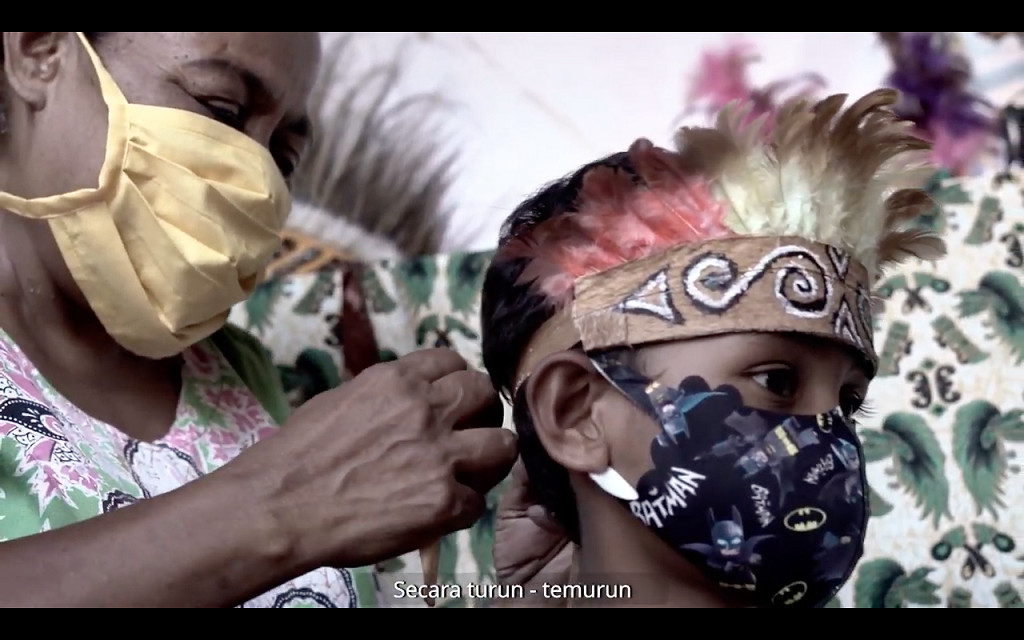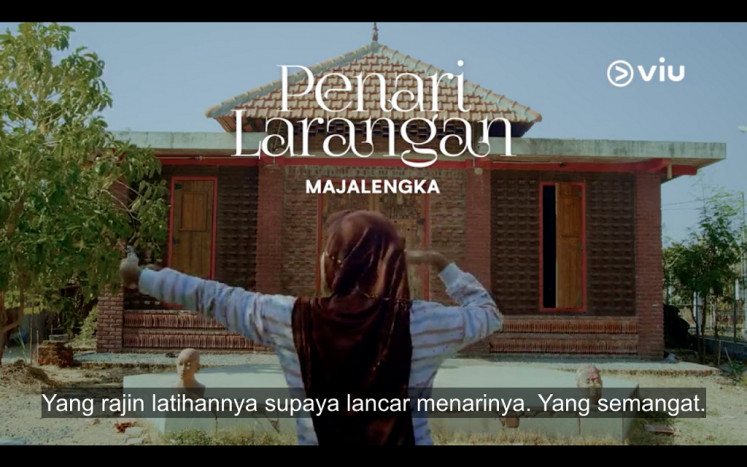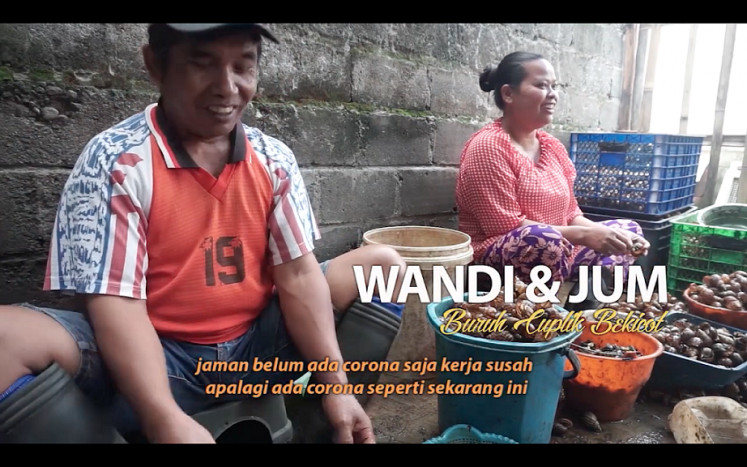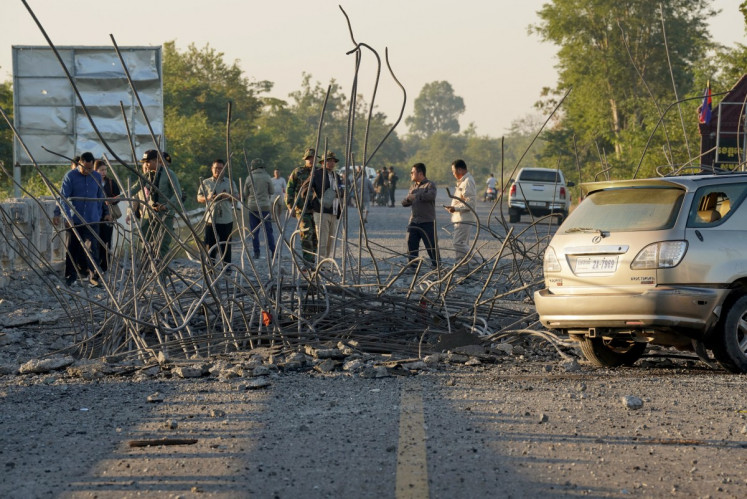Popular Reads
Top Results
Can't find what you're looking for?
View all search resultsPopular Reads
Top Results
Can't find what you're looking for?
View all search resultsIndonesian docs on the lookout for producers, compelling storytelling style
Even before the health crisis that forced people to stay home, documentaries had become the most prestigious form of creative expression.
Change text size
Gift Premium Articles
to Anyone
T
here is a common misconception that nonfiction films, such as documentaries, are not as appealing as feature films and, therefore, do not sell well, but filmmakers and an exhibitor beg to differ.
Alien’s film director, Sir Ridley Scott, had secured a spot at the 2021 Sundance Film Festival to screen a participatory documentary that would be based on footage sent by world citizens depicting their life events on July 25.
Under the working title Life in a Day to be helmed by documentary director Kevin Macdonald, the project would serve as an archive of the historical 2020 when the world shared the brunt of the COVID-19 pandemic.
Legends and legacy: Docuseries "The Last Dance" chronicles the rise of US basketball team Chicago's Bulls in the 1990s. Since the premiere in April, it averaged nearly 5.7 million viewers across all 10 episodes that made the series the most-watched ESPN documentary of all time. (IMDB/-)The health crisis hit the film industry badly but it less impacted the documentary filmmakers. Eagle Institute Indonesia, which organizes Eagle Docs Awards, for example, initiated Recording from Home projects, while the Archipelago Documentary Filmmakers Association (ADN) organized the Records of the Pandemic program as part of an effort to archive the current realities.
Even before the health crisis that forced people to stay home, documentaries had become the most prestigious form of creative expression.
The government, nonprofit organizations, and popular brands used feature documentaries – or at least apply the documentary film-making style in conveying subliminal messages without a strong advertising agenda – for purposes ranging from going viral and changing minds to winning awards.
The technology advancement in video-making and the art of storytelling that keeps finding new ways to compel viewers are among reasons documentaries are considered mainstream in the film industry.
They were no longer the boring montage of black-and-white archive images and talking heads, as we could watch in the library of our favorite United States-based subscription-based video-on-demand platforms (SVODs).
The appetite for documentaries in Asia also grew. The two-decade old Hong Kong International Film & TV Market, the annual FilMart, launched its Doc World section in 2018. It had seen notable growth in one year, with 290 exhibitors from 26 countries recorded last year – an increase of 30 percent from its pilot year.
There were also 24 nonfiction titles in screening sessions, a jump from 2018’s 13 titles, while the event’s pitching section doubled the total number of projects to include feature-length documentaries – a decision that showed a trend of growing documentary funding.
Hong Kong-based SVOD platform Viu, which covers 16 countries in Asia, the Middle East and South Africa, revealed that 90 percent of the Korean content in its library – which frequently topped the viewing chart – were documentaries.
Capturing Indonesia: High school students produce pseudo-documentaries on myths in their hometown. The original production of video-on-demand platform Viu, the program called Viu Shorts! has begun its second season with 16 short movies. (Viu/Tertiani ZB Simanjuntak)Myra Suraryo, senior vice president marketing of Viu, said a documentary could gain commercial value if the content was easy to digest and the delivery compelled viewers.
“Viewers are more inclined toward watching programs with real-life events they can connect or relate to,” she said at an Eagle Cinematalk show themed “Documentaries as an Investment to Civilization” on July 2.
“Documentaries serve as a great emotional escape and source of knowledge presented in interesting ways,” she added.
Organized by Eagle Institute Indonesia, which concerns the education and development of Indonesian documentaries, Myra and Makassar-based documentary filmmaker Andi Arfan Sabran talked about the commercial economy of Indonesian documentaries and their potential to reach the global market.
Slowly, but sure: A screengrab from a documentary titled "Bekicot di Tengah Pandemi" on the slumping market of the edible snails amid the pandemic. Eagle Institute Indonesia initiates Merekam Dari Rumah (Recording from Home) program to support documentary filmmakers. (Eagle Institute Indonesia/-)Indonesia has a robust production of documentaries, as seen from numerous competitions and film festivals held every year, such as the Eagle Awards, Indocs, Aceh Documentary Competition, Jogja Netpac-Asian Film Festival (JAFF) and the Indonesian Film Festival (FFI), to name a few.
However, documentaries with Indonesian content that can reach the global market have been made by Dutch director Leonard Retel Helmrich with his trilogy (The Eye of the Day, The Shape of the Moon and The Position of the Stars) on the impact of Islamic fundamentalism; while Denmark-based Brit director Joshua Oppenheimer’s The Act of Killing (2012) and The Look of Silence (2014) were nominated for Oscars.
Arfan said Indonesian filmmakers were still lacking in packaging a story in a manner that appealed to different segments of local audiences, let alone the global market.
“In making documentaries, we have to figure out who our audience is and how the film will impact them before going to the next step, finding the best way to communicate the story to the target audience.
“And you may make it in different versions to fit either your audience in your region, Indonesia, or at the international level.”
Sharing his experience of devising a business proposal to get his upcoming documentary premiered in Japan, with discussion attendees mainly representing film communities in different regions, Arfan said the era of multitasking as writer and director, handling the camera and doing the project pitching was long gone.
“A good producer is scarce as everyone wants to be a film director,” he added.
“I considered myself lucky to work with a producer who usually works on feature films but willing to go the extra length to convince the investors.”
Myra said her team at Viu worked with film communities in the regions to develop not only ideas and creative proposals but also business proposals.
“It is best to have businesspeople as producers to fill in the gap between art and the commercial economy. In the production of acclaimed films or series, among the largest investment went to research, not only for the story itself but also market behavior, potential investors and even suitable exhibitors – a practice still lacking in developing countries,” she said.
Viu as the exhibitor created Viu Shorts!, a documentary film-making project involving high school students from different provinces that host established film communities.
In its first season last year, 17 documentaries were screened that collected more than 1 million viewers from 16 countries in the first 28 days, sitting in the top three of the most-viewed during the year and top 20 programs today.
One of the films titled Miu Mai directed by Eka Putra Nggalu of Maumere, East Nusa Tenggara, was screened in Cannes and won the Best Short Form Content award at the 2019 Asian Academy Creative Awards.
For this year, Viu had prepared 20 films but due to the pandemic, only 16 were ready for release this week.
“Indonesia needs more quality films made by local talents that appeal to the global market. This country is rich with culture and is a farm for intellectual property. Local content is so unique and cannot be replicated by other countries,” said Myra.
“I encourage all filmmakers to heed the growing demand and to secure the intangible assets of documentaries. If there is one thing we learned from the Viu Shorts! program, films can bring in tourists, improving the economy of the regions, as well as the film communities.”













